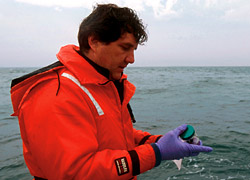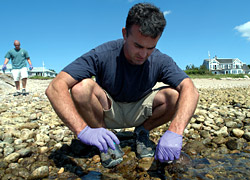Please note: You are viewing
the unstyled version of this website. Either your browser does not support CSS
(cascading style sheets) or it has been disabled. Skip
navigation.
On April 27, a single-hulled barge carrying 4.1 million gallons of Number 6 "Bunker C" fuel oil was gashed open (likely by rocks) while being tugged through Buzzards Bay to a power plant in Sandwich, MA. Within hours, an estimated 22,000 to 55,000 gallons of viscous, tarry petroleum had spilled into the waters of one of New England's richest tourist and shell-fishing grounds. In the days after the spill, Reddy and Nelson left their offices in the Marine Chemistry and Geochemistry Department and cruised from Cuttyhunk to Cleveland Ledge on several small boats, including WHOI's Mytilus. They scooped up floating "pancakes" of thick oil and filled bottles with water slicked by a thin blue sheen. In the following weeks, they were joined by Research Associate Li Xu (Geology and Geophysics), Guest Investigator Emily Peacock, Summer Student Fellow Brian Kile, and Oceanographer Emeritus George Hampson (Biology) as they surveyed beaches and marshes around the bay and collected oil-covered cobbles and sediments. "This is a unique opportunity to study oil as it is weathering," said Reddy, whose team has collected more than 60 samples. "We have a chance to determine the original chemical composition of the oil and assess its potential toxicity. Over time we can observe how the oil decays as it is acted on by the environment." In the laboratory, the researchers are using comprehensive two-dimensional gas chromatography, a novel process that separates and identifies the chemicals in a sample. Oil mixtures such as No. 6 fuel oil are complex, made up of hundreds of individual chemicals. These chemicals vary in their characteristics (volatility, solubility, etc.) and in their toxicity. A more complete knowledge of the chemical makeup will guide scientists and policymakers to a better understanding of its effects. "Chris and his colleagues have taken a new, very sensitive, and remarkably discriminatory analytical method from chemical research and brought it to bear on the fate of oil in the environment," said John Farrington, WHOI Vice President of Academic Programs and an expert on the effects of oil spills. "They are looking in fine detail, over time, at how different environmental and biological factors affect that oil, right down to the constituent molecules. This is fundamental knowledge that we just don't have." Reddy and colleagues are a long way from publishing their findings, but the early results show a large amount of napthalenes in the oil. Those compounds appear to be less persistent than other fractions of petroleum, but more volatile and toxic to fish and shellfish populations. On the positive side, Reddy reports that no salt marshes "appear to have been affected in a notable way." Reddy has been passing his data along to the response team headed by the National Oceanic and Atmospheric Administration. The rapid response to the April spill hearkens back to the response by another generation of WHOI researchers who tracked a 1969 spill in Wild Harbor of West Falmouth, MA. "Reddy's work is a next-generation leap from the ground-breaking studies by Max Blumer, Howard Sanders, and John Teal" said Farrington of the former WHOI Senior Scientists who were his mentors. "In those days, once an oil slick was gone, it was out of sight, out of mind. When the Wild Harbor spill occurred, Max, John, and Howard were able to sample it and show that even after the oil was no longer visible, it was still in the water and the mud. No one had brought the latest analytical chemistry techniques and geochemical and biological knowledge to bear on oil spills. They fundamentally changed our view of the impact of oil spills." Reddy was already scheduled to give a talk at the Coalition for Buzzards Bay's annual State of the Bay Conference on his own studies of the 1969 Wild Harbor spill when the new spill occurred. He soon found himself speaking at a community briefing on the April 2003 oil spill instead. Reddy has since been flooded with calls and email requests for nformation, and The Island Foundation Inc. has awarded a grant to support Summer Student Fellows to accelerate studies of the new spill. Originally published: July 1, 2003 Last updated: May 24, 2011 | ||||||||||||||||
Copyright ©2007 Woods Hole Oceanographic Institution, All Rights Reserved, Privacy Policy. | ||||||||||||||||



